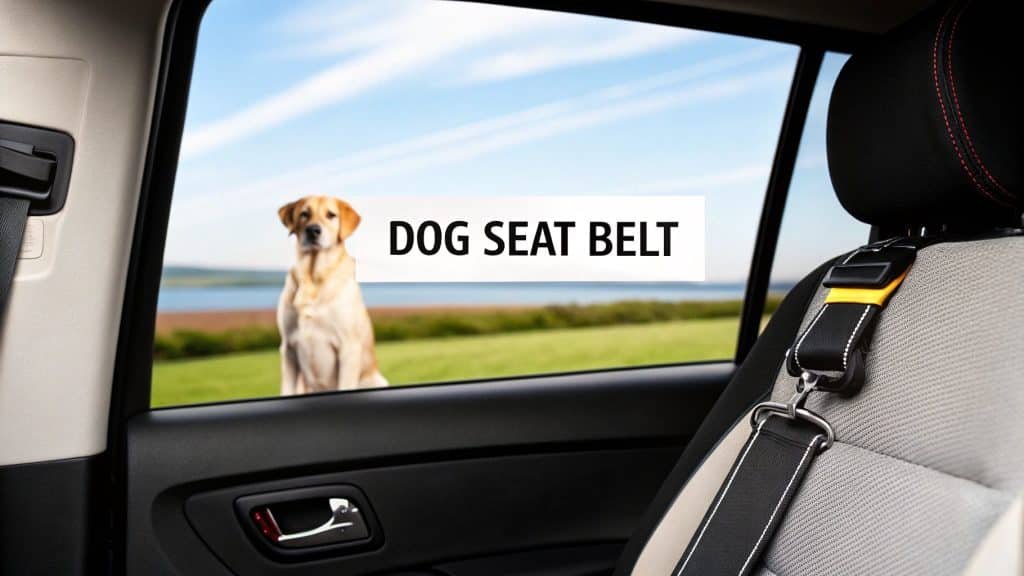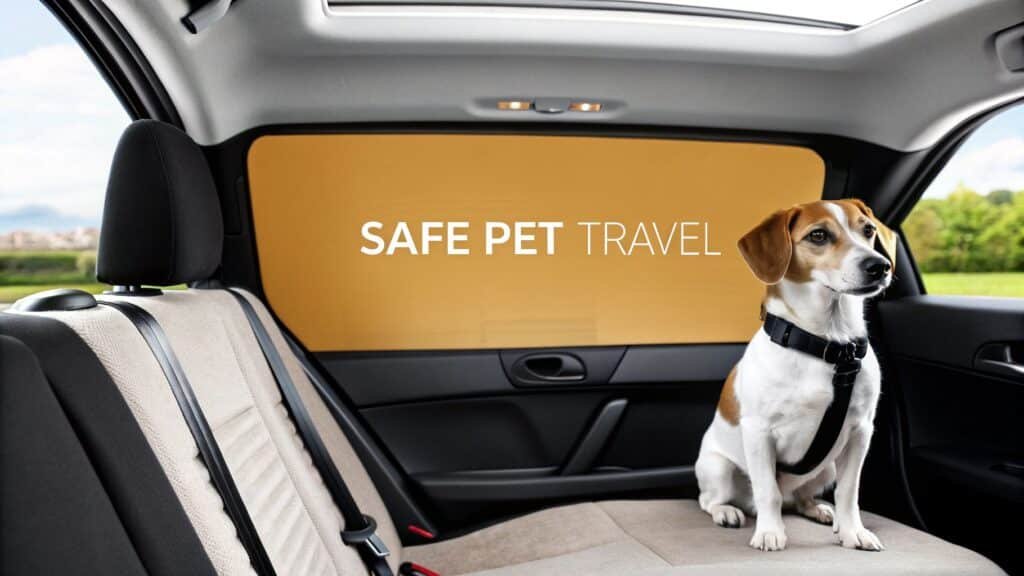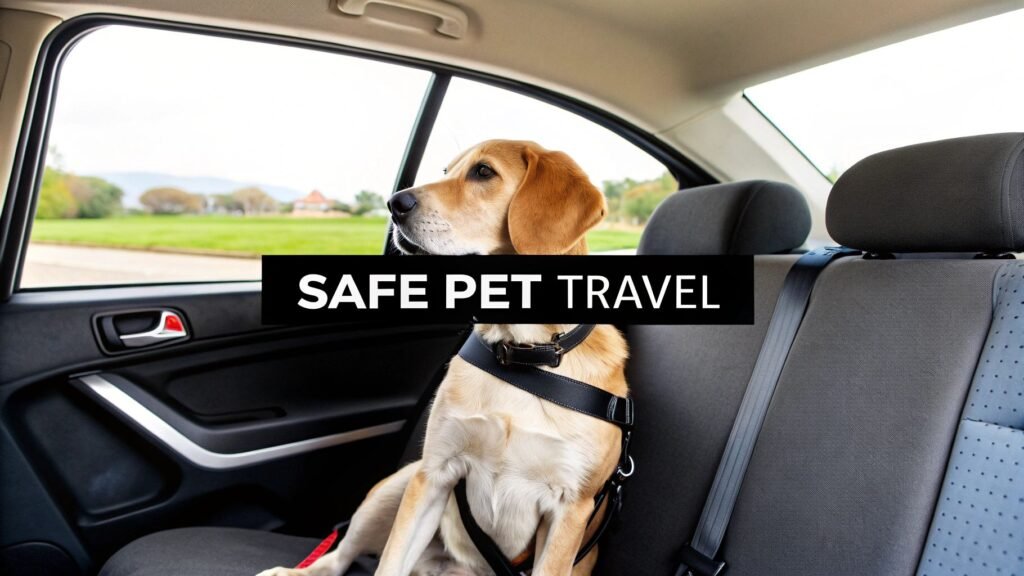Best Pet Travel Accessories for Safe Journeys
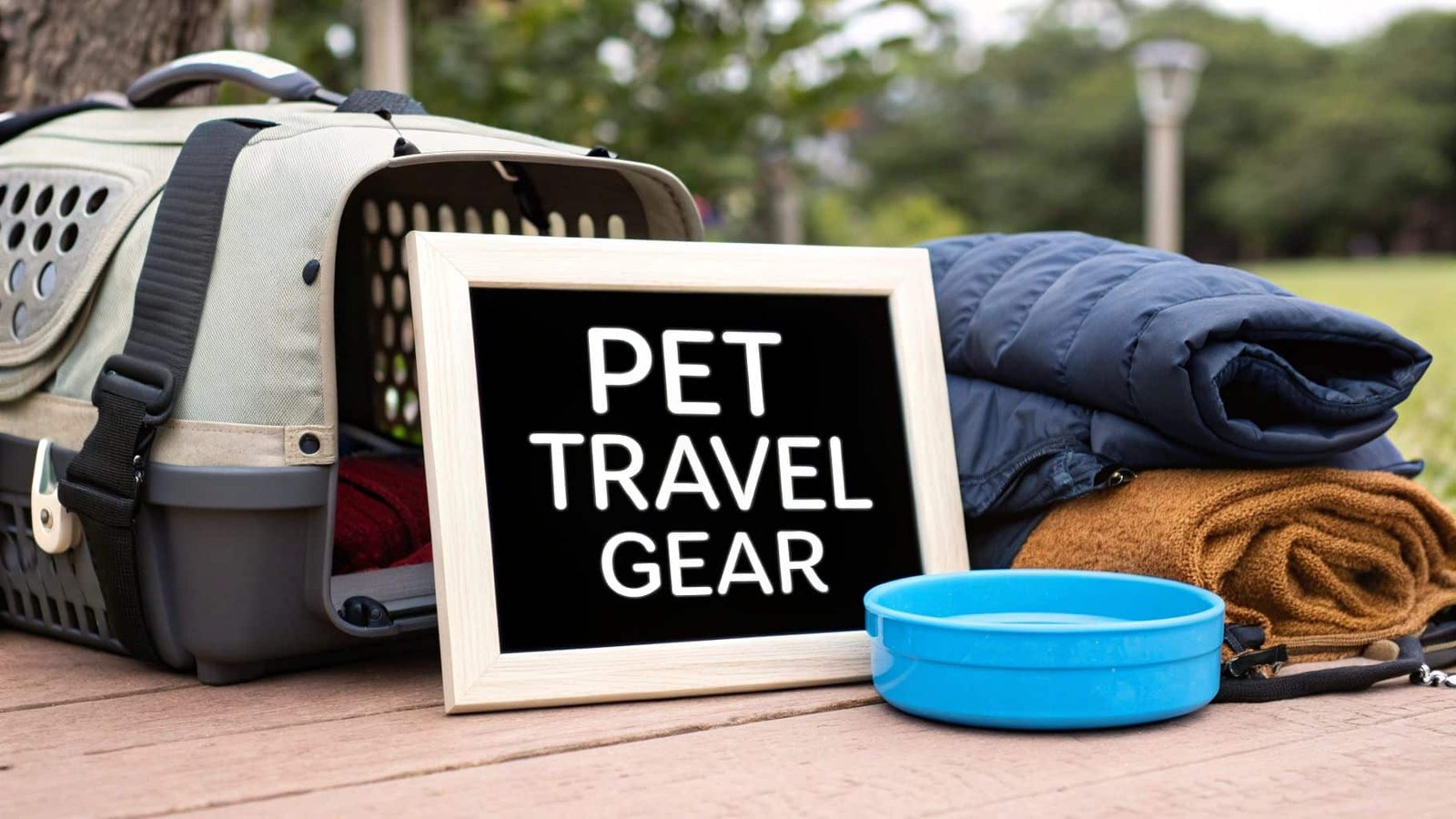
The best travel gear for your pet is all about putting safety first and comfort a close second. Think of things like a crash-tested car harness or an airline-compliant carrier. Investing in the right equipment means your pet stays secure and calm, which can turn a stressful trip into a great memory for both of you.
Get Ready to Travel With Confidence
Taking a trip with your pet should be fun, not a nail-biting experience. But the collar, leash, and bowls you use every day just aren’t cut out for the road. The unique challenges of a long car ride or a flight call for gear designed specifically for safety and convenience while in motion.
It’s a bit like this: you wouldn’t wear flip-flops to go hiking. Sure, they’re shoes, but they aren’t the right shoes for the job. In the same way, your dog’s cozy bed at home isn’t engineered to keep them safe in a moving car. This guide will help you see past the basic stuff and truly understand what makes for great pet travel gear.
Why You Can’t Skip the Specialized Gear
Picking the right accessories is about more than just making things easier—it’s a core part of being a responsible pet owner. Travel-specific equipment is built to handle the physics of a moving vehicle or meet the strict rules of an airline. It solves problems that your everyday pet supplies don’t even consider.
Here’s why it’s so important to have the right tools for the trip:
- Real Safety: A travel harness that has been crash-tested is designed to protect your pet in a sudden stop or an accident. Your standard walking harness offers zero protection in that scenario.
- A Calmer Pet: A well-designed travel carrier or a secure car seat gives your pet their own safe space, almost like a portable den. This can make a huge difference in reducing their anxiety and even preventing motion sickness.
- No More Last-Minute Stress: Using an airline-compliant carrier means you won’t face any surprise issues at check-in. And things like spill-proof water bowls help keep your car clean and your trip running smoothly.
This push for better, safer pet gear is part of a bigger shift in how we see our animals. More and more, pets are treated like family, and that means we want high-quality, purpose-built accessories for them. This “pet humanization” trend is fueling massive growth in the industry, with the global pet travel accessories market expected to hit USD 8.2 billion by 2032. All this growth means we have more and better options than ever before. You can explore more of the market’s growth insights over at Dataintelo.
Incorporating the Best pet travel accessories into your travel preparations will enhance your pet’s comfort and safety during trips.
Once you learn to tell the difference between what’s absolutely essential for safety and what’s a nice-to-have for comfort, you can put together a travel kit that makes every trip a good one. That knowledge turns you from a worried owner into a prepared and confident travel buddy, ready for whatever adventure comes next.
Selecting the Right Carrier for Maximum Safety
When you’re gearing up to travel with your pet, the carrier is more than just a box. It’s their personal safety cell for the entire journey. Think of it exactly like a car seat for a child—the right model, a perfect fit, and proper installation are absolutely critical for their protection. Whether you’re hopping on a plane or hitting the road, the carrier is the single most important piece of gear for a safe trip.
The first big question you’ll face is whether to go with a hard-sided or a soft-sided carrier. They’re built for completely different situations, and your travel plans will dictate which one is the right call. Picking the wrong one can cause major headaches, from getting denied at the airline check-in counter to putting your pet at risk in the car.
Hard-Sided Carriers for Air Travel Security
If you’re flying, a hard-sided carrier is almost always what you’ll need, especially if your pet is traveling in the cargo hold. These carriers are made from tough, rigid plastic designed to handle the bumps, jostling, and even stacking that can happen behind the scenes. They offer far better protection from impacts and keep the carrier from getting crushed under pressure.
Airlines are serious about their rules, and most follow the guidelines set by the International Air Transport Association (IATA). Showing up with an IATA-compliant carrier is your best bet for a smooth, stress-free check-in.
Here’s what you need to look for to make sure a hard-sided carrier is flight-ready:
- Solid Construction: The shell must be rigid plastic. Critically, the door needs to be metal, not plastic, to stop a determined pet from chewing or breaking its way out.
- Secure Locking Mechanism: Look for a spring-lock system on the door that’s easy to operate without tools. The top and bottom halves of the carrier must be fastened together with metal nuts and bolts, as plastic clips are a common reason for rejection.
- Proper Ventilation: To ensure your pet gets plenty of fresh air, there must be ventilation on at least three sides of the carrier. Four sides is even better.
- Correct Sizing: This is crucial. Your pet needs to be able to stand up, turn around, and lie down comfortably. Measure them from the top of their head to the floor (for height) and from the tip of their nose to the base of their tail (for length) to get the right dimensions.
A common mistake is getting a carrier that’s too big, thinking it’s more comfortable. The opposite is true. In turbulence, a carrier with too much extra space can be dangerous, as your pet could be thrown around inside. A snug, correct fit is always the safer choice.
Soft-Sided Carriers for Road Trip Safety
When you’re traveling by car, soft-sided carriers can be a great option, especially for smaller pets. While they don’t have the same crush-proof structure as hard-sided models, their biggest advantage is how they perform in an accident. The best ones are designed to be secured with a seat belt, essentially turning them into a contained car seat.
The gold standard here is crash-test certification. Organizations like the Center for Pet Safety (CPS) perform rigorous, independent crash tests on pet travel products. A CPS-certified carrier has been proven to keep a pet safely contained during a collision, preventing them from becoming a projectile that could harm them or anyone else in the car.
This infographic shows how carrier types and safety certifications line up with different ways to travel.
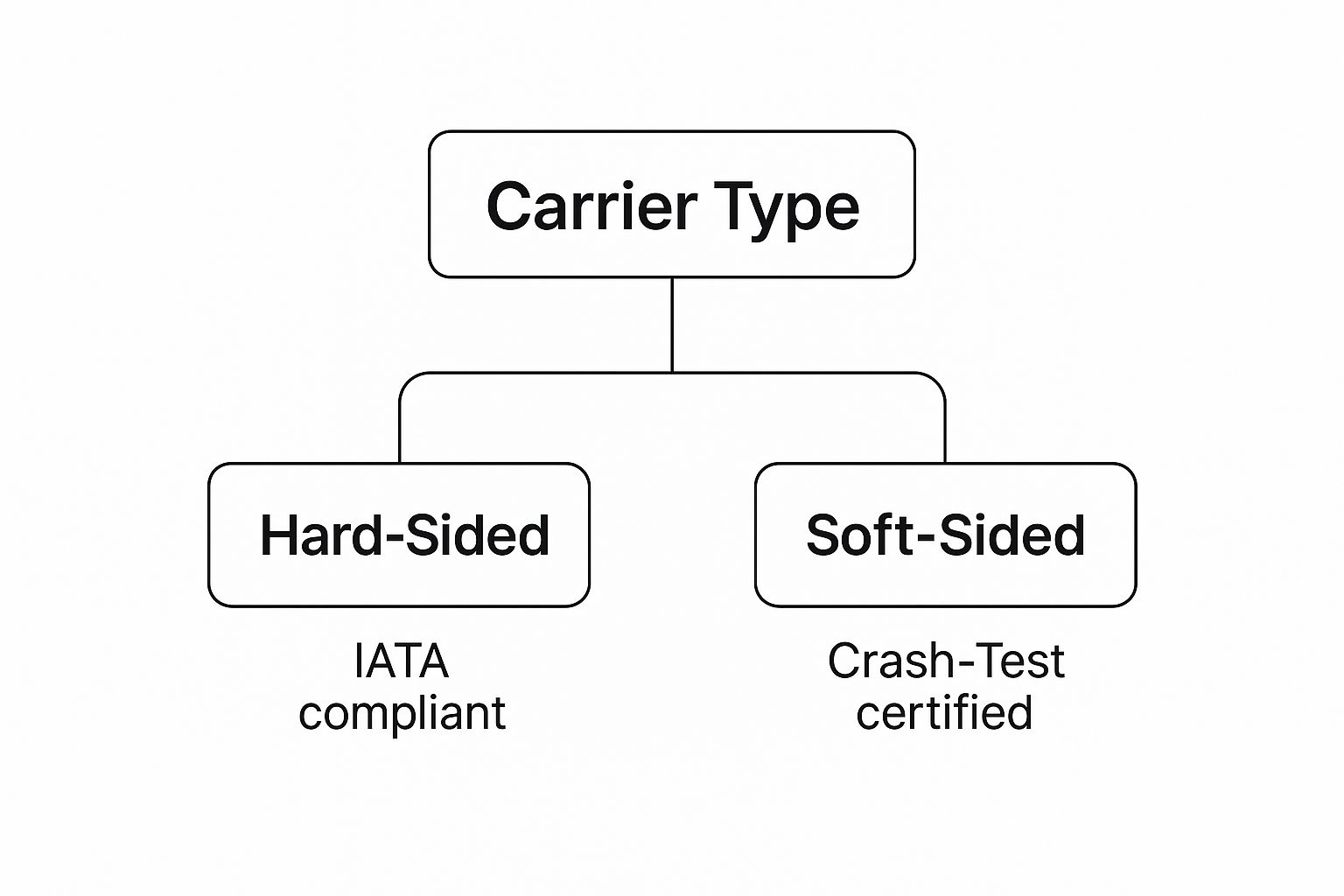
As you can see, hard-sided carriers are all about meeting IATA standards for flying, while soft-sided carriers are judged by crash-test certifications for road safety. Knowing this difference is key to picking the right gear. Your choice should always be driven by how you’ll be traveling to make sure you’re meeting the right safety standards for the situation.
Mastering Car Safety Beyond the Crate
It’s a scary thought, but an unrestrained pet in a moving car is a serious hazard. We’re not just talking about the distraction they can cause; we’re talking about physics. In a sudden stop from just 30 mph, a 60-pound dog can fly forward with an impact force of 2,700 pounds. That’s a risk no one should be willing to take.
Securing your best friend is non-negotiable, and thankfully, there are some fantastic, crate-free options out there. These specialized restraints are engineered to handle the massive forces of a collision, keeping your pet safely in their seat. Think of them as a seat belt system, but built specifically for your dog’s body. The best ones have been put through the wringer with rigorous testing to prove they’ll hold up when it counts.
https://www.youtube.com/embed/j9wnNe-ozaE
The Gold Standard: Crash-Tested Harnesses
A crash-tested harness is arguably one of the best ways to keep your dog safe in the car. This isn’t your average walking harness. These are built with beefy, heavy-duty webbing, reinforced stitching, and solid metal hardware designed to withstand incredible force without snapping.
When you loop the car’s seat belt through it, the harness is designed to spread the force of a sudden stop across the strongest parts of your dog’s body—the chest and shoulders. This simple design prevents them from becoming a projectile and, just as importantly, protects their delicate neck and spine. A high-quality harness is a must, and you can explore options like this durable tactical dog harness that’s built for both strength and comfort.
When you’re shopping, keep an eye out for certification from the Center for Pet Safety (CPS). This independent organization runs serious crash tests on pet safety products. Their seal of approval is the gold standard, giving you peace of mind that your gear is truly up to the job.
A “crash-tested” claim without third-party certification from a group like CPS is just marketing. True safety comes from independent, scientific testing that proves the product can perform under the extreme stress of a real-world accident.
Pet Car Seats and Boosters
For smaller dogs, a dedicated pet car seat or booster is a fantastic blend of safety and comfort. It gives them a little lift so they can see out the window, which can work wonders for anxiety and car sickness. But more importantly, it provides a secure, contained space.
The best ones install using your car’s own seat belt, locking the seat firmly in place so it won’t slide around on sharp turns. Your pet is then secured inside the booster using a short, integrated tether that clips to their harness (never, ever their collar). It’s a two-part system that keeps them snug and safe.
The market for pet car seats has exploded, and it’s projected to make up about 27.3% of the market share by 2025. This tells you just how many owners are looking for secure and comfortable solutions, and you can get more details about this trend from Coherent Market Insights.
Vehicle Barriers for Larger Dogs
Got a big dog or need to keep your pet in the cargo area of your SUV? A vehicle barrier is your best friend. These are sturdy metal grates that install between the back of your car and the passenger area, creating a wall that stops your dog from launching forward in a crash.
When you’re choosing one, look for a model that bolts securely to the vehicle’s frame or uses a heavy-duty mounting system to anchor to the headrests. Avoid the cheap, tension-mounted barriers that just press against the floor and ceiling—a strong dog can push them over, and they’re likely to fail completely in a collision.
To make sure your restraint system is as effective as possible, always keep these tips in mind:
- Measure for the Perfect Fit: A harness that’s too loose won’t work correctly, and one that’s too tight is uncomfortable and dangerous. Always measure your dog’s chest girth and check it against the manufacturer’s size chart.
- Use a Harness, Not a Collar: Never, ever attach a seat belt tether directly to a collar. The force from an accident can cause severe or even fatal neck injuries.
- Position Restraints Correctly: Your pet should always be secured in the back seat. The front passenger seat is the most dangerous spot due to the force of deploying airbags.
By choosing the right certified gear and using it correctly every time, you can turn every car trip into a safe and worry-free adventure for your four-legged companion.
Keeping Your Pet Comfortable and Calm
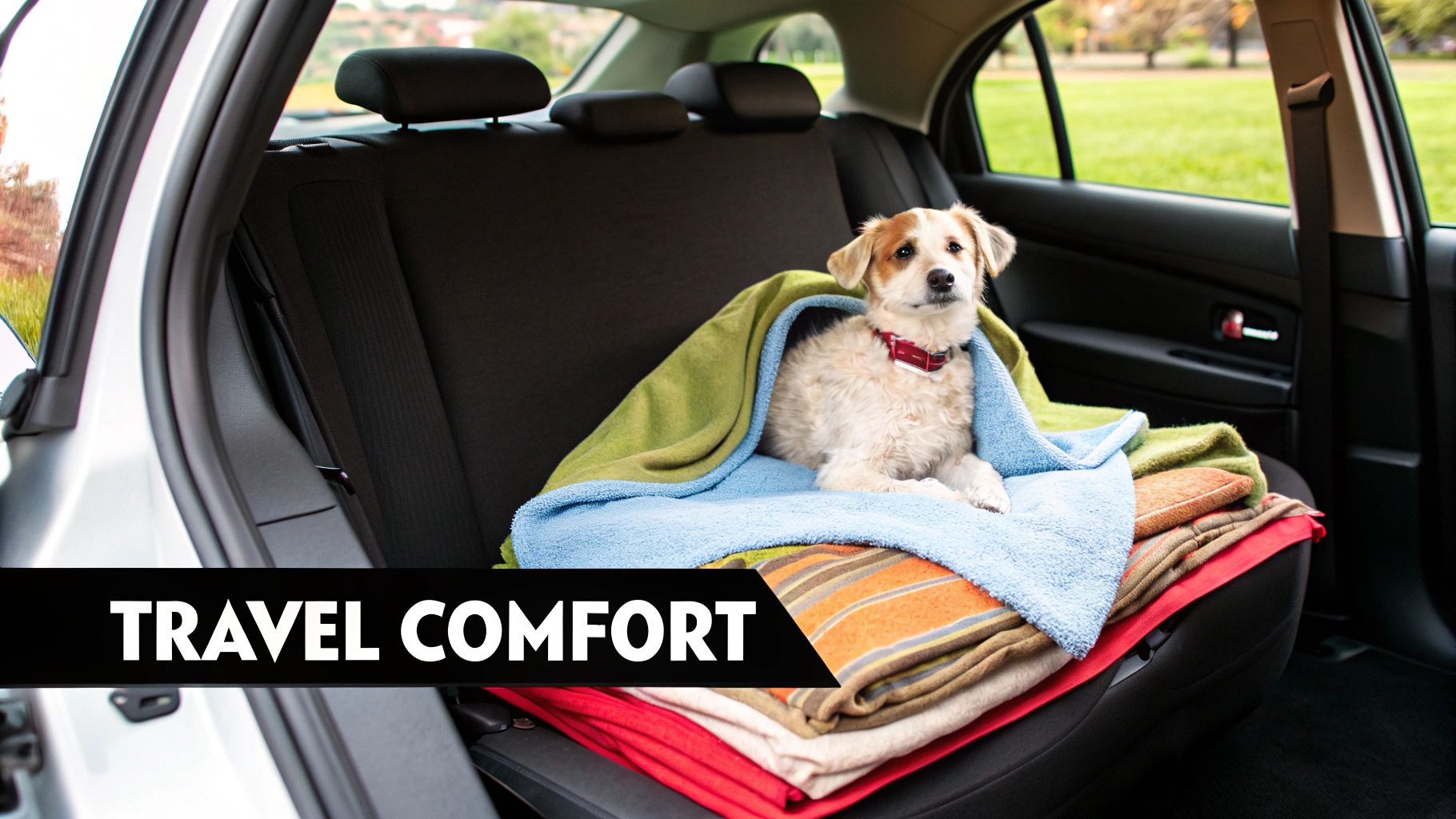
While safety gear is the absolute must-have for any trip, a comfortable pet is what makes the journey fun for everyone. Let’s face it, travel can be stressful for our furry companions. It throws off their routine and puts them in strange, new places. The right accessories can create a little bubble of comfort and calm, turning a potentially rough experience into a good one.
Think of it as packing a little piece of home. Simple, familiar items can make a world of difference to your pet’s state of mind. A comforting scent, a steady temperature, and a feeling of security can bring their anxiety way down. This focus on wellness is a big reason the pet care industry keeps growing.
Creating a Soothing Environment
One of the easiest tricks in the book for reducing travel anxiety is to surround your pet with familiar smells and textures. For animals, scent is a powerful thing, so bringing a few key items from home is a super effective, low-effort strategy.
A soft travel bed or their favorite blanket gives them a designated “safe spot” in the car or carrier. A great tip is to have your pet sleep on the blanket for a few nights before you leave. That way, it’s loaded with their scent and the comforting smell of home, creating a tangible piece of their territory they can bring along for the ride.
The demand for these kinds of comfort-focused products is booming. The global pet accessories market was valued at a huge USD 30.6 billion in 2024 and is expected to climb to USD 49.0 billion by 2033. This surge shows just how much we’ve come to understand the importance of pet wellness. If you’re curious about the numbers, you can dive into the full report from IMARC Group.
Managing Temperature for Ultimate Comfort
Nothing makes a pet more antsy than being too hot or too cold. Temperature swings on a trip can quickly turn a happy traveler into a miserable one. Thankfully, there are specialized accessories designed to keep them just right, whether you’re driving to the mountains in winter or the beach in summer.
For warm weather adventures, check these out:
- Cooling Mats: These are genius. They contain a pressure-activated, non-toxic gel that absorbs your pet’s body heat, creating a cool surface to lie on without any refrigeration needed.
- Elevated Beds: Think of a mini cot with a breathable mesh surface. It allows air to flow all around your pet, so heat doesn’t get trapped underneath them.
When you’re heading somewhere chilly, self-warming liners and beds are fantastic. They’re made with materials that reflect your pet’s own body heat back at them, creating a perfectly cozy spot without any cords or electricity.
Key Takeaway: A pet that is physically comfortable is far more likely to be emotionally calm. Managing their temperature is one of the most direct ways to ensure they remain relaxed throughout the journey.
Figuring out whether to prioritize safety gear or comfort items can be tricky, especially when you’re just starting out. This table breaks down the main purpose of different accessories to help you decide what you need most.
Comfort vs Safety Accessory Breakdown
| Accessory | Primary Function (Safety/Comfort) | Best For | Key Feature to Look For |
|---|---|---|---|
| Crash-Tested Harness | Safety | Car travel for dogs of all sizes | Crash-test certification (e.g., CPS) |
| Secure Carrier | Safety | Small dogs, cats, air travel | Hard-sided, proper ventilation, secure latch |
| Anxiety Wrap | Comfort | Anxious pets in any travel situation | Snug but not restrictive fit |
| Cooling Mat | Comfort | Warm climates, summer road trips | Non-toxic, pressure-activated gel |
| Car Seat Cover | Comfort & Protection | Protecting car interior, providing grip | Waterproof, non-slip backing |
| Travel Bed | Comfort | Creating a familiar “safe space” | Portable, machine-washable |
Ultimately, a mix of both safety and comfort accessories will give you the most peace of mind and your pet the best possible travel experience.
Advanced Anxiety Aids
For some pets, a favorite blanket just isn’t enough. If your companion needs a little extra support, there are some great products designed specifically to soothe their nerves. An anxiety wrap or thunder shirt, for instance, applies gentle, constant pressure around your pet’s torso. It’s a lot like swaddling a baby and can have an incredibly calming effect on their nervous system.
Another powerful tool is a pheromone diffuser. These products release a synthetic version of the calming pheromones that mother animals produce. You can find them as sprays, wipes, or even plug-in diffusers for your car. They essentially send signals of safety and reassurance straight to your pet’s brain, helping to dial down stress in new situations. Using these tools together can be a game-changer for a peaceful trip.
Essential Gear for Hydration and Feeding On the Go
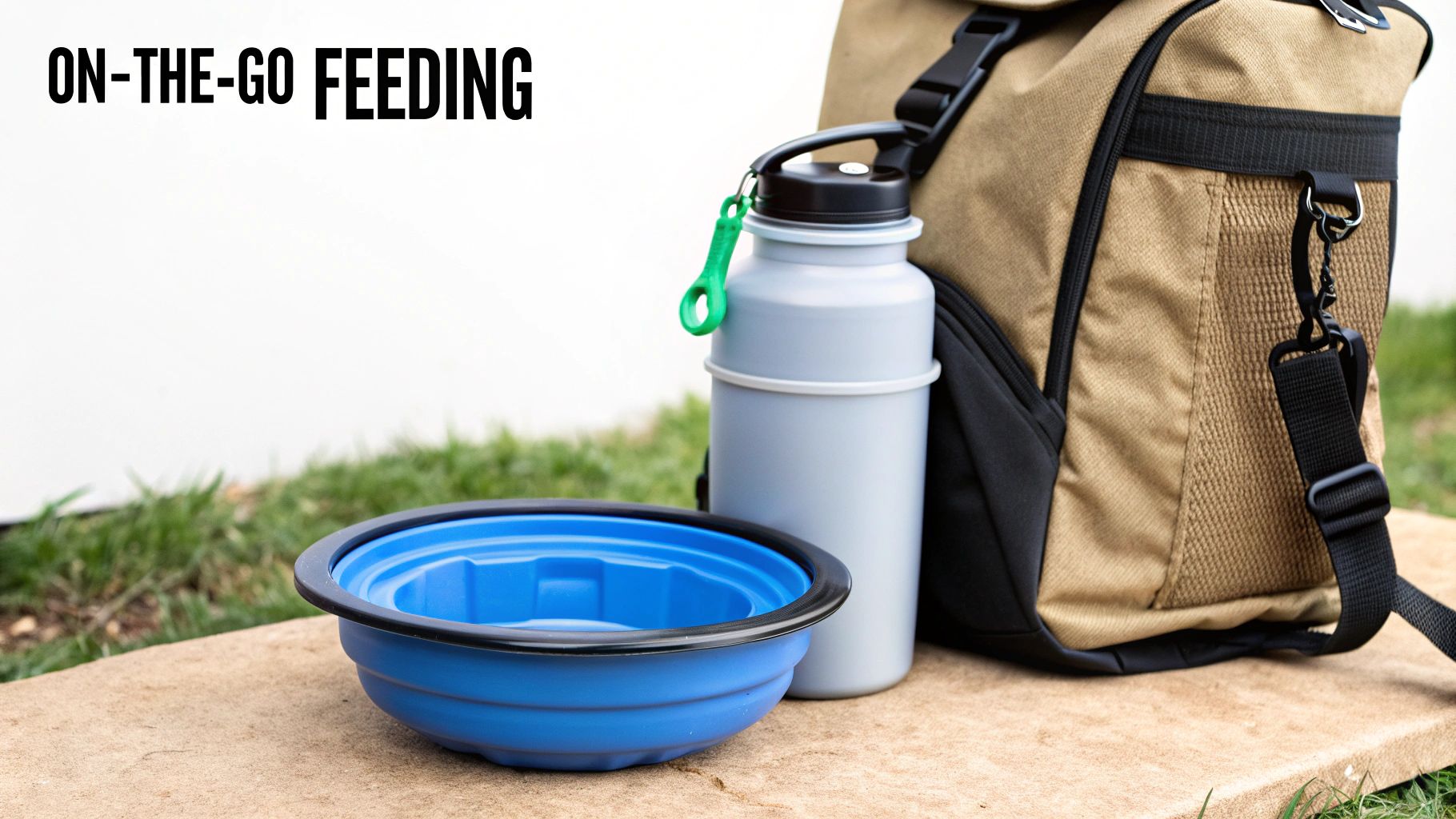
One of the best ways to keep a pet feeling secure during a trip is by sticking to their routine as much as possible. Mealtime is a huge part of that. Think about it—the sound of kibble hitting their bowl or the sight of their water dish are powerful, comforting cues that everything is okay, even when the scenery outside is new and strange.
Of course, you can’t just toss their heavy ceramic bowls in the back seat and hope for the best. That’s where specialized travel gear comes in. The best accessories for feeding and watering on the road are all about three things: being portable, easy to clean, and simple to use. Get this right, and mealtime remains a happy, stress-free part of the day for everyone.
Choosing Your Travel Bowls and Dispensers
Forget those bulky, clunky bowls of the past. Today’s travel solutions are designed to be incredibly convenient, often collapsing down to fit into a backpack pocket or glove compartment. Collapsible silicone bowls are a fan favorite for good reason—they’re lightweight, tough, a breeze to clean, and take up almost no room when flattened.
For car rides, a spill-proof water dispenser is an absolute lifesaver. Many of these look like a water bottle with a small bowl attached. You just press a button to release water into the bowl, and when your dog is done, any leftover water drains right back in. No waste, no mess. You can see some great examples by exploring different types of feeding bowls and travel dispensers built for adventures.
Here’s a simple trick I swear by for car trips: fill a bowl with water and pop it in the freezer for a bit before you go. It melts slowly, giving your pet cool water for hours while seriously cutting down on the sloshing and spills at the start of your drive.
Keeping Food Fresh and Organized
Making sure your pet’s food stays fresh and contained is just as crucial as how you serve it. An airtight food container is non-negotiable. It keeps kibble from getting stale and, just as importantly, locks in that tempting food smell so your curious pup isn’t trying to break into the supply bag in the back seat.
For maximum convenience, I always pre-portion meals into separate zip-top bags before a trip. This little bit of prep saves a ton of hassle later. Instead of fumbling with a giant food bag and measuring cups at a crowded rest stop, you can just grab a bag and go. It makes feeding fast, clean, and keeps your pet on their schedule without any fuss.
When you’re shopping around, keep these practical points in mind:
- Food-Safe Materials: Always check that products are made from BPA-free silicone or food-grade plastic. You don’t want any nasty chemicals getting into your pet’s food or water.
- Easy to Clean: Travel gear gets grimy. Look for items that are either dishwasher-safe or have smooth surfaces you can wipe down in a few seconds.
- Durability: This gear is going to get packed, unpacked, and probably dropped a few times. Make sure you pick sturdy accessories that can handle the reality of the road.
By choosing the right feeding gear, you take what could be a travel headache and turn it back into a simple, grounding routine. It’s a small thing that makes a huge difference in helping your pet feel at home, no matter how far from it you are.
Gearing Up for Outdoor Fun and Inevitable Messes
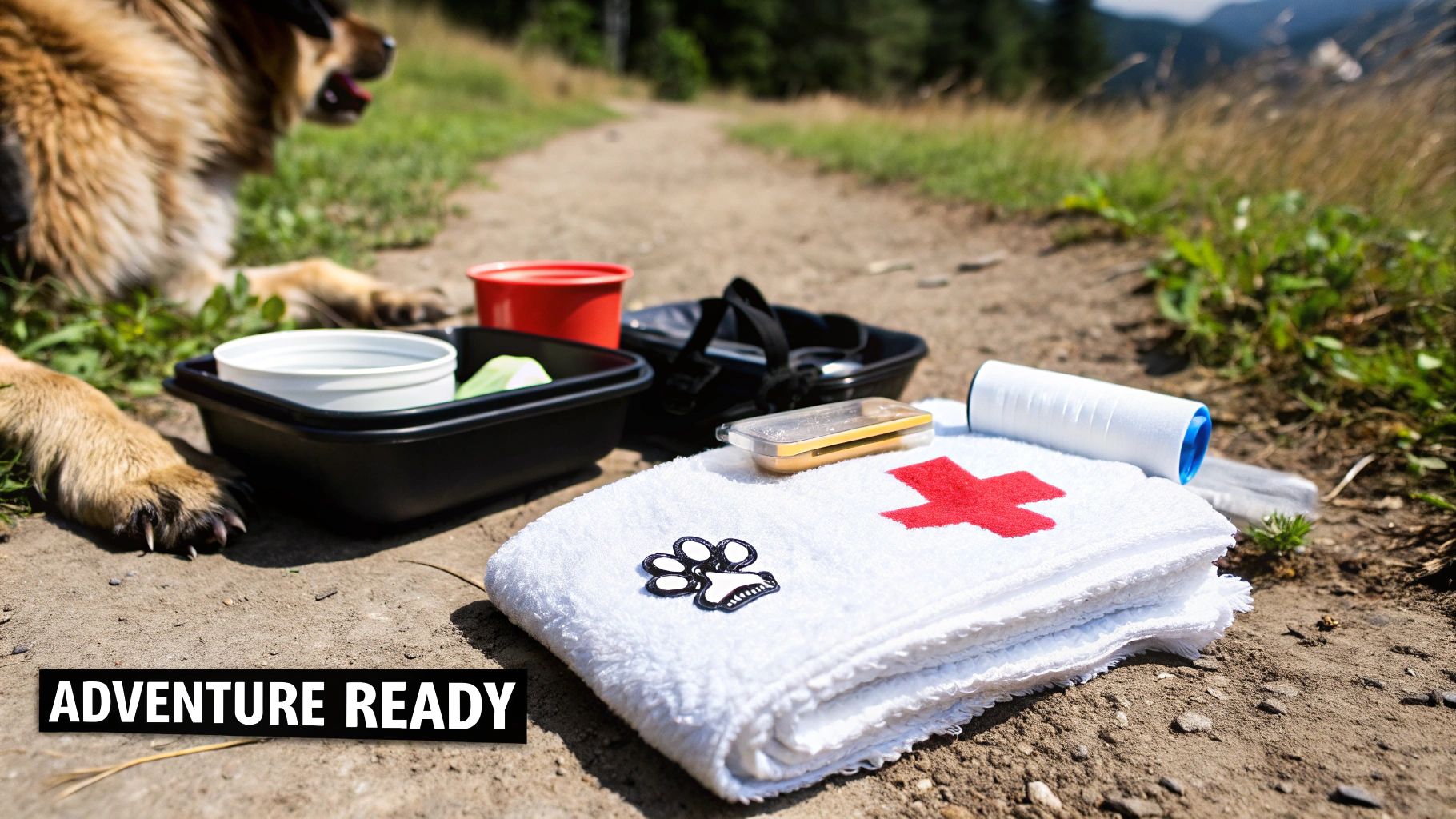
Hitting the trails, splashing at the beach, or setting up a campsite with your four-legged friend—these are the adventures we live for. But let’s be honest, they also guarantee a whole lot of mess. The good news is, embracing the great outdoors doesn’t mean your car has to look like a swamp afterward.
With the right gear, you can turn a potentially chaotic cleanup into a quick, manageable routine. Think of it as packing two different toolkits: one for safety and fun on the trail, and another for handling the muddy aftermath. This way, you can say “yes” to that tempting mud puddle or sandy dune, knowing you’re ready for whatever your pet brings back.
Keeping Your Pet Safe and Comfortable on the Trail
Before you even step out of the car, you need to think about protecting your pet. Hot pavement can scorch paw pads in seconds, and sharp rocks can lead to nasty cuts. Extreme weather, whether hot or cold, also poses a real threat to their well-being.
Here are a few pieces of protective gear I never leave home without:
- Dog Booties: These are a must-have for rocky hikes or walks on hot asphalt. They act as a tough shield against sharp objects and extreme ground temperatures, saving your dog from a world of hurt.
- Cooling Vests: For adventures in the summer heat, a cooling vest can literally be a lifesaver. You just soak it in water, and it uses the power of evaporation to help keep your dog’s core temperature down, preventing dangerous overheating.
- Reflective Gear: If there’s any chance your hike might last until dusk, a reflective collar, harness, or vest is non-negotiable. It makes your pet highly visible to you, cars, and other people, drastically improving their safety in low light.
A well-stocked pet first-aid kit is just as critical as your own. Make sure it has essentials like antiseptic wipes, gauze, self-sticking bandages, and tweezers for splinters or ticks. Being able to treat a minor cut on the spot can keep a small issue from turning into a big one.
Taming the Mess After the Adventure Ends
Once the fun is over, the second challenge begins: keeping all that dirt, sand, and water from destroying your vehicle’s interior. This is where a few key accessories really earn their keep, saving you from permanent stains and lingering odors.
Your first line of defense should be a waterproof seat cover or cargo liner. It creates an unbeatable barrier over your upholstery, so mud and moisture never even touch the fabric. I always look for models with a non-slip backing to ensure they stay put, no matter how much your dog wiggles around. They’re one of the smartest investments an adventurous pet owner can make. For smaller messes, or for lining a crate, it helps to know your options; exploring the pros and cons of reusable dog pee pads vs disposable pads can give you more versatile cleanup solutions.
Finally, you can stop dirt right at the source with a portable paw washer. It’s a genius little gadget—basically a silicone-bristled cup that quickly and gently scrubs mud off your dog’s paws before they jump into the car. Keep an ultra-absorbent microfiber towel handy to dry them off, and you’ll contain the mess before it ever has a chance to spread.
Got Questions About Pet Travel Gear? We’ve Got Answers.
When you’re getting ready to travel with your pet, the sheer number of gadgets and gear can be overwhelming. It’s totally normal to have a few questions. We’ve been there! To cut through the noise, we’ve compiled straightforward answers to the questions we hear most often from fellow pet owners.
Think of this as a practical cheat sheet. It’s designed to build on what we’ve already covered, helping you feel confident that you’re making the safest and most comfortable choices for your best friend.
What’s the One Accessory I Absolutely Can’t Skimp On?
If you only buy one thing, make it a secure, properly fitted restraint. This is the non-negotiable foundation of safe travel.
In a car, that means either a crash-tested harness buckled into the seat belt or a travel crate that’s been firmly anchored. For flights, it’s an airline-compliant carrier. This single piece of equipment does two critical jobs: it stops your pet from becoming a dangerous distraction and, more importantly, it protects them from severe injury if you have to brake suddenly or get into an accident.
How Do I Know if a Carrier Is Actually Airline-Approved?
This is a huge point of confusion, and for good reason. A lot of products claim to be “airline-approved,” but the truth is, the final say always comes down to the specific airline you’re flying with.
A good starting point is to look for carriers labeled “IATA-compliant.” This signals that they meet a baseline international standard for safety and ventilation that most major airlines adhere to. But don’t stop there. Before you even think about clicking “buy,” pull up your airline’s website and find their specific rules for pet travel. You need to know their exact dimension and material requirements, especially for in-cabin carriers that have to slide under the seat in front of you.
A five-minute check on your airline’s website can spare you the nightmare of being denied at the gate because your carrier is an inch too tall. Always, always double-check their policy before you fly.
Is a Pet Car Seat Really Safer Than Just Holding Them?
Yes. One hundred percent, absolutely. It might feel comforting to hold your pet on your lap, but it’s one of the most dangerous things you can do in a moving vehicle.
An airbag deploys with explosive force, which can be fatal for a small animal caught in its path. Even in a fender bender, your pet could be crushed or launched through the cabin. A proper pet car seat or booster uses an integrated harness that clips directly into the car’s seat belt system, keeping them secure. For real peace of mind, make sure you choose a model that has been independently crash-tested.
What Essentials Should I Put in a Pet First-Aid Kit?
Every pet owner should have a travel first-aid kit ready to go. You can find great pre-made ones, but it’s also easy to build your own.
Make sure you have these basics covered:
- Gauze pads and non-stick bandages for wrapping injuries.
- Adhesive tape and a small pair of scissors.
- Antiseptic wipes and a sterile saline wash for cleaning wounds.
- Tweezers for any pesky splinters or ticks.
- A pet-specific item like styptic powder, which is a lifesaver for bleeding nails.
Don’t forget to add a supply of your pet’s personal medications and a card with your vet’s number and the hotline for an animal poison control center. A little preparation goes a long way.
At Ur Pet Store, we know that having the right gear is what turns a stressful trip into a great memory. We’ve handpicked a wide selection of high-quality, durable, and safe travel accessories to give you total peace of mind on the go. Get ready for your next adventure by exploring our travel collection.


